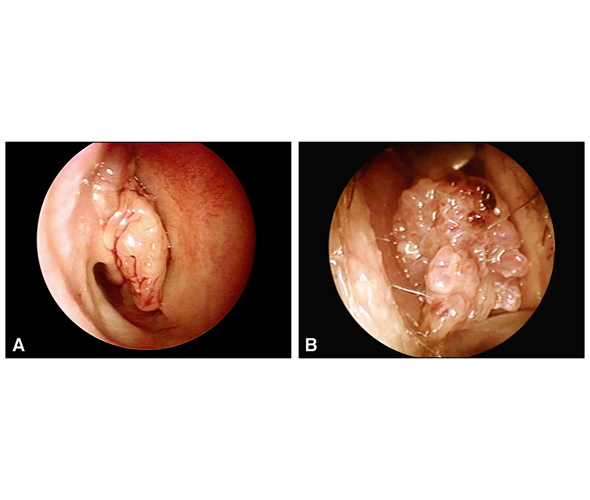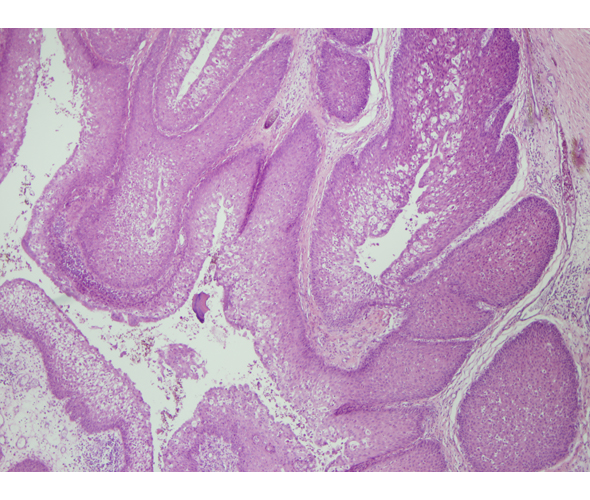Benign:
1.
What is the differential diagnosis of benign sinonasal tumors?
2.
Describe the clinical presentation and classification system for Juvenile Nasopharyngeal Angiofibroma (JNA).
3.
Describe the surgical approaches for excision of JNAs and compare the advantages and disadvantages of each approach. What is the role of embolization in the management of JNA?
4.
What are the different types of papillomas of the nasal cavity? Where do they originate in the nasal cavity?
5.
What is the diagnosis of the pathology shown on these nasal endoscopic images? Discuss the differential diagnosis, etiology and long term history of this clinical entity.
Reference(s):
Mendenhall W, Hinerman R, Malyapa R, Werning J, Amdur R, et al. (2007). Inverted papilloma of the nasal cavity and paranasal sinuses. Am J Clin Oncol ,30(5), 560-563.
Krouse J.H. (2000). Development of a staging system for inverted papilloma. Laryngoscope, 110(6), 965-8.
6.
Describe the histopathology shown here. Discuss the surgical management options for the patient with this lesion.
Reference(s):
Melroy, C. T., & Senior, B. A. (2006). Benign sinonasal neoplasms: a focus on inverting papilloma. Otolaryngologic Clinics of North America, 39(3), 601–17, x.
7.
How can a surgeon reduce the recurrence rate of inverted papillomas?
Reference(s):
Healy, D. Y. J., Chhabra, N., Metson, R., Holbrook, E. H., & Gray, S. T. (2016). Surgical risk factors for recurrence of inverted papilloma. The Laryngoscope, 126(4), 796–801.
8.
Discuss the malignant transformation of inverted papilloma.
Reference(s):
Dubal, P. M., Bhojwani, A., Patel, T. D., Zuckerman, O., Baredes, S., Liu, J. K., & Eloy, J. A. (2016). Squamous cell carcinoma of the maxillary sinus: A population-based analysis. The Laryngoscope, 126(2), 399–404.
Malignant:
9.
What is the differential diagnosis of malignant sinonasal tumors?
10.
Where are the most common locations of origin of malignant sinonasal tumors?
11.
Describe the AJCC staging system for sinonasal cancers.
12.
What are some different staging systems proposed for olfactory neuroblastomas?
13.
Describe the signs and symptoms of sinonasal tumors. Which of these are likely to be associated with malignant lesions?
14.
Describe the role of CT and MRI imaging in the evaluation of sinonasal tumors. What is the typical appearance of tumor on T1 and T2 imaging? What impact does gadolinium enhancement have on the appearance of tumor?
15.
How do chordoma and chondrosarcoma differ on radiographic imaging?
16.
What is a sinonasal undifferentiated carcinoma and how does it compare with an esthesioneuroblastoma?
17.
Discuss extramedullary plasmacytomas of the sinonasal tract.
18.
Describe the known occupational risk factors associated with the development of sinonasal squamous cell carcinomas and adenocarcinomas.
19.
What is the prognosis of SCC of the maxillary sinus?
20.
Review sinonasal adenoid cystic carcinoma
Reference(s):
Husain, Q., Kanumuri, V. V, Svider, P. F., Radvansky, B. M., Boghani, Z., Liu, J. K., & Eloy, J. A. (2013). Sinonasal adenoid cystic carcinoma: systematic review of survival and treatment strategies. Otolaryngology–Head and Neck Surgery : Official Journal of American Academy of Otolaryngology-Head and Neck Surgery, 148(1), 29–39.
21.
Compare the indication, limitations and potential complications of the following surgical approaches to the nasal cavity and the paranasal sinuses: lateral rhinotomy, midface degloving, medial maxillectomy and total maxillectomy.
22.
Is there a role for endoscopic surgical approaches to sinonasal tumors? What are the limits of an endoscopic surgical approach?
Reference(s):
Hanna E, DeMonte F, Ibrhim S, Roberts,D, et al. (2009). Endoscopic Resection of Sinonasal Cancers with and without Craniotomy. Arch Otolaryngol Head and Neck Surg, 135, 1219-1224.
Naunheim M.R., Goyal N, Dedmon, M.M, Chambers K.J,et al. (2016). An Algorithm for Surgical Approach to the Anterior Skull Base. J Neurol Surg B Skull Base, 77(4), 364-70.
23.
Discuss other appropriate treatment modalities of sinonasal cancers.
24.
What are some indications for orbital exenteration in sinonasal tumors?
25.
Discuss the complications of radiation to the eye?



